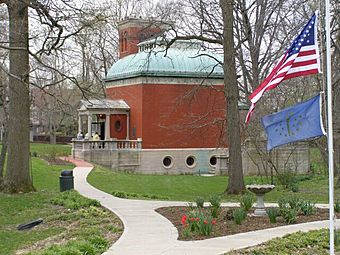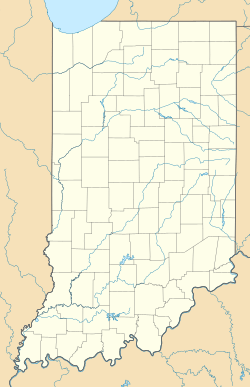General Lew Wallace Study facts for kids
|
Gen. Lew Wallace Study
|
|
|
U.S. Historic district
Contributing property |
|

Gen. Lew Wallace Study
|
|
| Location | 200 Wallace Ave., Crawfordsville, Indiana, United States |
|---|---|
| Built | 1895 |
| Architect | Wallace, Gen. Lew |
| Architectural style | Greek Revival, Other, Romanesque |
| Part of | Elston Grove Historic District (ID92000187) |
| NRHP reference No. | 76000013 |
Quick facts for kids Significant dates |
|
| Added to NRHP | May 11, 1976 |
| Designated NHL | May 11, 1976 |
| Designated CP | March 25, 1992 |
The General Lew Wallace Study & Museum is a special place in Crawfordsville, Indiana. It used to be known as the Ben-Hur Museum. This museum celebrates the life of Lew Wallace, a famous general, writer, and diplomat. It was named a National Historic Landmark in 1976. In 2008, it received a National Medal for its great work. The museum is part of the Elston Grove Historic District.
The main building, called the Study, was designed by Wallace himself. The nearby carriage house is also part of the museum. These two buildings are the only ones connected to Lew Wallace that still look as they did long ago. Inside, you can see many items Wallace used during his life. You can also find objects related to his famous book, Ben-Hur: A Tale of the Christ. You can take a guided tour of the Study for a small fee. The Carriage House Interpretive Center and the museum grounds are free to visit.
Lew Wallace's Story
Lew Wallace is most famous for his military service and his novel Ben-Hur: A Tale of the Christ, published in 1880. He fought for the Union Army during the American Civil War. He took part in important battles like the Battle of Fort Donelson and the Battle of Shiloh. He also helped manage army operations in Indiana during a Confederate invasion in 1863.
After the war, Wallace served on military commissions. He then began to focus on writing. His first novel came out in 1873. In 1880, he published Ben-Hur: A Tale of the Christ. This book is set during the time of Jesus Christ in the Roman Empire. At first, it did not sell well. But soon, it became the bestselling novel of the 1800s. It remained the top seller until Gone with the Wind was published.
Ben-Hur is considered a very important Christian book from the 1800s. It has always been available to buy since it was first published. It has also been made into four movies. Besides writing, Wallace worked as a lawyer. He was also a governor for the New Mexico Territory. Later, he became an ambassador to Turkey. He wrote a total of seven books, including novels and biographies. He also enjoyed art, inventing, and music.
Wallace built his study because he wanted a quiet place to think and write. He called it "a pleasure-house for my soul." He wanted it to be "a detached room away from the world and its worries." Wallace passed away in his home on February 15, 1905. After he died, his family allowed the public to visit his study. In 1941, a local group bought the property and gave it to the city of Crawfordsville.
The carriage house opened in 2006. It is now called the Carriage House Interpretive Center. This is where visitors start their tour. It used to be used by groups like the Girl Scouts. Today, it has a changing exhibit, a gift shop, and a video about Wallace. It also holds offices and stores museum collections.
The Study's Design
The study took three years to build, from 1895 to 1898. It cost between $25,000 and $30,000. Wallace designed this unique building himself. He used ideas from different styles, including Byzantine, Greek, and Romanesque architecture.
The building is one story tall and made of dark red bricks. It has a copper dome roof that is about 30 feet high. A copper, glass, and steel cupola sits on top of the dome. This cupola protects a large skylight over the main room. Limestone from southern Indiana was used for the porches and outside decorations.
A special carved stone band, called a frieze, runs along the top of the walls. Faces carved into the frieze represent characters from Wallace's books. On the tower, you can see Princess Irene. On the back, there is the Prince of India. Both are from his book The Prince of India. To the east is Tirzah, Ben-Hur's sister. Above the entry is Judah Ben-Hur. Both are from Ben-Hur: A Tale of the Christ.
A small curved room at the back of the building was for the building's mechanics. It held light switches and levers to open windows in the dome. The bricks used for this curved room are specially shaped. The study also has a 40-foot-tall tower on its west side. This tower has Roman arches. It was originally bricked in, except for two stained glass windows. The tower was not just for looks. It also worked as a chimney and held a water tank for the original bathroom in the basement.
You can see the full basement through round windows on the east side. It holds Wallace's workbench, where he created his nine inventions. The furnace that heated the building is also there. The Wallaces' carriage was stored in the basement too. You can also see the strong steel beams and concrete that support the study.
Visiting Today
When the city of Crawfordsville took over the building, it became known as the Ben-Hur Museum. Its official name is now the General Lew Wallace Study & Museum. It still displays many of the 1,200 books Wallace owned. The furniture inside the study is original. This includes the chair Wallace used when writing his masterpiece, Ben-Hur. He finished this book long before he built the study.
Other items in the collection include his military uniforms, artwork, and musical instruments. You can also see the fishing rod he invented. One piece of art is a portrait of the daughter of the sultan of Turkey. The sultan gave this portrait to Wallace in 1885.
The Carriage House Interpretive Center has new exhibits each year. These exhibits show different sides of Wallace's life. Past exhibits have included Collective Influence: The Wallace Women and Lew Wallace - Gentleman Scientist. Another exhibit was Embattled: General Wallace's Leadership in the Civil War.
The 3.5-acre land around the study is a public park. Many people use it for picnics, walking dogs, and taking family photos. The park has beautiful flower beds. In recent years, more people have visited to search for a geocache hidden on the site.
Guided tours of the study are available for a small admission fee. The Carriage House Interpretive Center and the grounds are open to the public for free.
See also



